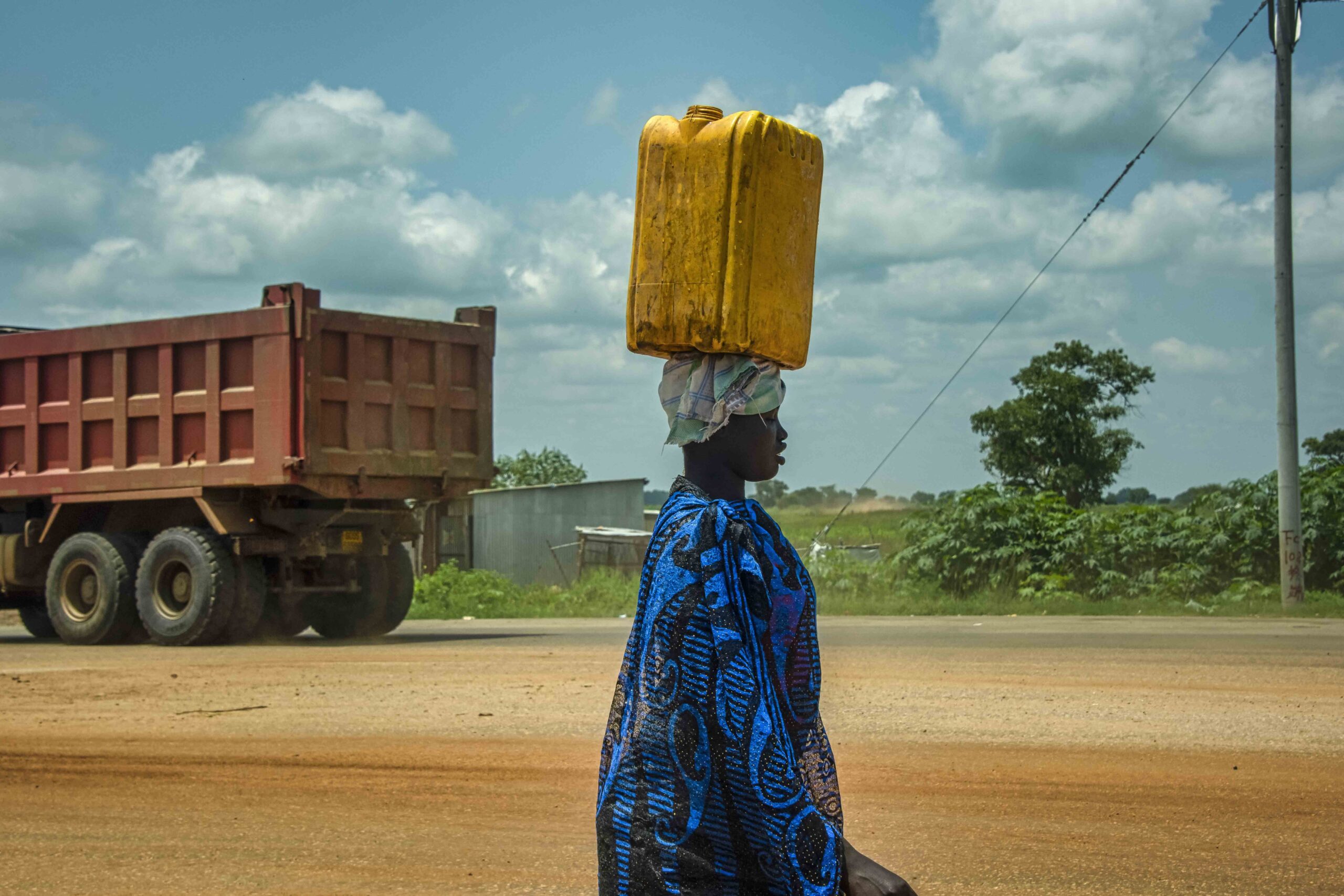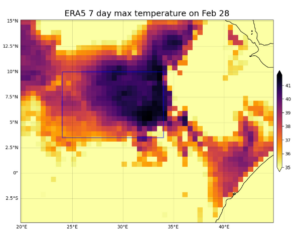Skip to main content

Unanticipated Heatwaves Disrupt Life Across Sub-Saharan Africa
Since mid-February, an intense and unexpected heatwave has swept across a significant portion of East Africa, with South Sudan experiencing some of the most severe conditions. Record-breaking daytime temperatures have severely impacted residents living in makeshift housing and outdoor workers, representing a substantial segment of the population. In Juba, the capital, dozens of children suffered heatstroke, prompting a nationwide school closure for two weeks starting February 20. Authorities advised residents to stay indoors and maintain hydration, but these measures are challenging in a country where many homes lack cooling systems, reliable electricity, and access to clean water. Notably, approximately one-third of Juba’s residents lack access to potable water, and only 1% of the city’s housing offers shade or cooling options for those without home-based air conditioning.
Heatwaves are among the most lethal climate-related events, with impacts extending well beyond immediate mortality. They influence health, agriculture, infrastructure, and economic stability, often with underreported death tolls and delayed recognition of their full scope. In South Sudan, the early impacts already reveal a disproportionate burden on women and girls, exacerbating existing gender inequalities. The current situation underscores the urgent need for comprehensive strategies to address these vulnerabilities.
Researchers from a diverse group of countries-including Burkina Faso, Kenya, Uganda, the Netherlands, Germany, Austria, Denmark, Sweden, Mexico, Chile, the United States, and the United Kingdom-collaborated to analyze how human-driven climate change has amplified the risk and severity of these extreme heat events. Their goal is to identify pathways toward more equitable climate resilience, especially during International Women’s Day, a time when global attention is directed toward women’s livelihoods. This study concentrates on South Sudan, where the highest temperatures have been recorded, impacts are most evident, and vulnerability to heat is critically high. The focus is on the week in February when the maximum temperatures reached their peak, based on the seven-day average maximum temperature data.

Key Insights into Climate-Driven Heat Risks
- Gender plays a pivotal role in determining vulnerability and resilience to extreme heat in South Sudan. Women face significant challenges, including a maternal mortality rate of 1,223 per 100,000 live births-one of the highest globally-and a literacy rate of only 29%, compared to 40% among men. Women hold just 32% of parliamentary seats, reflecting gender disparities in political representation. The vast majority of employed women (95%) work in the informal sector, often in physically demanding jobs with high heat exposure, such as street vending or small-scale manufacturing.
- Women’s daily routines expose them to prolonged heat stress. Predominantly engaged in agriculture, domestic chores, and informal commerce, women spend around 60% of their day performing unpaid tasks like fetching water and cooking in sweltering environments. This persistent heat exposure, combined with physical exertion, can lead to serious health issues, including cardiovascular strain, kidney problems, and increased susceptibility to heat exhaustion and heatstroke.
- Educational disruptions threaten long-term development. Extended school closures due to extreme heat hinder learning, reinforce gendered expectations within families, and increase the risk of early marriage for girls. Adaptive measures-such as adjusting school schedules to cooler parts of the day, retrofitting classrooms with passive cooling solutions like shade trees or reflective roofs, and training teachers and students to recognize heat-related illnesses-can mitigate these risks at low cost.
- Malnutrition and health vulnerabilities are intensifying. With over 860,000 children under five already affected by malnutrition, extreme heat worsens food insecurity, weakens immune defenses, and raises dehydration risks, especially among girls in female-headed households. Limited access to nutritious food, healthcare, and income security perpetuates a cycle of poor health outcomes and deepens existing inequalities.
- Conflict and displacement compound heat-related dangers. Ongoing armed conflicts have displaced more than 1.1 million individuals into overcrowded shelters with poor ventilation, intensifying heat exposure. Displaced women and girls often lack access to cooling, clean water, and healthcare, making them more vulnerable to violence and health crises.
- Unseasonal temperature peaks are becoming more common. The highest temperatures of the year are now occurring earlier than historically typical, even in February. Today’s climate, warmed by approximately 1.3°C due to fossil fuel emissions, means that such extreme heat events are no longer anomalies. The 7-day maximum temperatures observed in 2023 would have been exceedingly rare in a cooler climate, highlighting the influence of global warming.
- Climate change significantly elevates the likelihood of extreme heat events. Combining observational data with climate models reveals that human-induced warming has increased the probability of such heatwaves by at least tenfold, with temperature anomalies being at least 2°C hotter than they would be in a pre-industrial climate. In a hypothetical 1.3°C cooler world, similar events would be about 4°C cooler, underscoring the profound impact of fossil fuel combustion on regional climate extremes.
- Future projections indicate escalating risks with continued warming. Even conservative estimates suggest that at a global temperature increase of 2.6°C, the frequency and severity of such heatwaves will intensify, posing greater threats to vulnerable populations.
- Targeted adaptation strategies can bolster community resilience. Practical interventions-such as increasing access to clean water, creating shaded communal spaces, and establishing cooling centers-are vital, especially in displacement camps and informal settlements. For example, the Ajuong Thok refugee camp, housing over 40,000 residents-most of whom are women-has implemented improved shelter designs to reduce heat stress.
- Gender-sensitive approaches are essential for effective climate adaptation. Supporting women farmers with climate-resilient agricultural techniques, enhancing labor protections for outdoor workers, and providing financial aid to vulnerable households can strengthen coping mechanisms. Early warning systems tailored to local contexts, developed by regional organizations like IGAD, are crucial for timely responses, but ensuring that warnings reach and are acted upon by at-risk populations remains a challenge.

